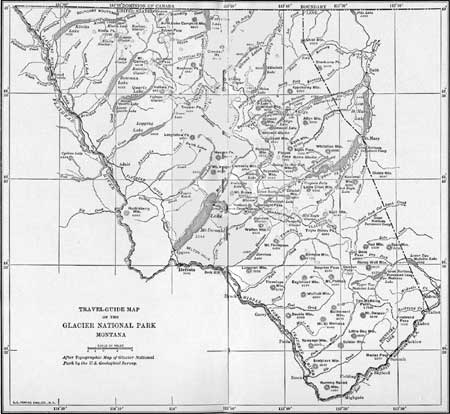|
GLACIER
Some Lakes of Glacier National Park |

|
SOME LAKES OF GLACIER NATIONAL PARK.
By MORTON J. ELROD, University of Montana
INTRODUCTION.
During the summers of 1909, 1910, and 1911 I spent considerable time in the study of the lakes of the Glacier Park. The object was to make observations in regard to their depth, and, in the case of those lakes which do not now contain fish, to make a study of the microscopic life as a source of fish food, and, in addition, to make soundings to determine the depth of the water, so as to arrive at a fairly satisfactory conclusion of those lakes as producers of fish.
Most of the larger lakes are connected with rivers through creeks which have no high falls, and which consequently admit fish from the rivers to the lakes. Many of the lakes are small. Some, however, are of considerable size and appear to be capable of supplying food for large numbers of fish.

|
| Travel-Guide Map of the Glacier National Park, Montana. (click on image for an enlargement in a new window) |
The method of taking soundings was as follows: An ordinary plumber's bob of lead or iron was used, with several hundred feet of heavy cord of the kind ordinarily used for trolling. This cord was passed through a piece of apparatus such as is used for measuring wire in installing telephones and telegraphs. All that was necessary was to adjust the apparatus on the edge of the boat and let the cord run out until the bottom was struck, then read the depth on the dial. The method of securing depth by this process is quite accurate if the water is still, and there is no question whatever about determining when the lead strikes the bottom of a lake.
The life of the lakes was determined by using a surface net made of No. 20 silk bolting cloth of the finest mesh procurable, such as is used in flour mills. Attached to this was a little brass bucket with little windows, which were covered with the same kind of silk cloth. The water was screened through the net and the specimens collected in the little bucket at the end, the whole thing being shaped like a funnel. The bucket is detachable, by this means making it possible to collect the life from a large quantity of water into a small space and preserve it for future study. A wooden plug was inserted in a small hole in the bottom of the bucket, and on removal of this the contents were easily transferred into a small vial or glass bottle. This net was dragged behind the boat for an indefinite distance at various places in the different lakes, and the contents in each case preserved and properly labeled. A second net consisted of a rectangular iron frame, with a silk cloth of larger mesh, intended to collect larger material, both from the surface and from the bottom. The mesh is sufficiently large to allow the passage through it of mud and the small specimens, and was intended only for the collection of the larger forms of life. By means of a rope this was allowed to drop to the bottom, if the lake was not too deep, or along the surface, or at a depth from the surface, as desired. This material also was collected and preserved for future study.
Most of the field work was done from a canvas boat, carried from place to place on a pack horse, as no other form of boat could be so transported; in some places wooded boats were available.
Owing to the large number of lakes in the park and of the difficulty of reaching so many in the short space of time that could be given, there are still many left to be studied. Some of these are easily accessible to the tourist and are doubtless capable of supplying food to an abundance of fish life. The park will be much more interesting if most of these lakes are stocked with fish; but to do so will require some knowledge of their depth, the quantity of life the water contains, and general information as to their surroundings, accessibility, insect life, and the like.
| <<< Previous | <<< Contents>>> | Next >>> |
elrod/intro.htm
Last Updated: 02-Apr-2007